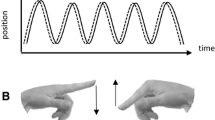Abstract
There were two purposes underlying this study: to describe the sensorimotor functioning of mute autistic children and to relate their sensorimotor performance to nonverbal communication. Twelve mute children, diagnosed autistic, ranging from 4 years 9 months to 12 years of age, were administered four scales of sensorimotor development from the Uzgiris and Hunt (1975) series: object permanence, gestural imitation, means for obtaining environmental events, and causality. Subjects performed most poorly on the imitation scale with 9 of 12 performing below Piaget's fifth sensorimotor stage. In contrast, performance was highest on the object permanence scale: No child scored below Stage V. Regarding the subjects' non-verbal communication, Stage V performance on the means and causality scales and Stage III on the imitation scale appeared to form minimal prerequisites for intentional communication in a variety of situations. Finally, none of the subjects, even those with relatively complete sensorimotor development, spontaneously used what Bates (1976) has called “protodeclarative” gestures to point out or show objects to adults. The absence of protodeclarative gestures may represent a qualitatively distinct pattern of prelinguistic development in certain autistic children.
Similar content being viewed by others
References
Bates, E.Language and context. New York: Academic Press, 1976.
Bates, E., Camaioni, L., & Volterra, V. The acquisition of performatives prior to speech.Merrill-Palmer Quarterly, 1975,21, 205–226.
Corman, H., & Escalona, S. Stages of sensorimotor development: A replication study.Merrill-Palmer Quarterly, 1969,15, 351–361.
Creak, M. Schizophrenic syndrome in childhood: Further progress report of a working party.Developmental Medicine and Child Neurology, 1964,6, 530–535.
Delany, F. I., & Fitzpatrick, M. M. Cognitive evaluation of the young disturbed child. In J. F. Magary, M. K. Poulsen, P. J. Levinson, & P. A. Taylor (Eds.),Piagetian theory and the helping professions: Proceedings from the sixth interdisciplinary seminar. Los Angeles: University of Southern California Press, 1977.
DeMyer, M. K., Alpern, G. D., Barton, S., DeMyer, W. F., Churchill, D. W., Hingtgen, J. N., Bryson, C. Q., Pontius, W., & Kimberlin, C. Imitation in autistic, early schizophrenic, and non-psychotic subnormal children.Journal of Autism and Childhood Schizophrenia, 1972,2, 264–284.
Gratton, L. Object concept and object relations in childhood psychosis.Canadian Psychiatric Association Journal, 1971,16, 347–354.
Lovaas, O. I.The autistic child. New York: Irvington Publishers, 1977.
Piaget, J.The origins of intelligence in children. New York: Norton, 1952.
Piaget, J.The construction of reality in the child. New York: Basic Books, 1954.
Piaget, J.Play, dreams, and imitation in childhood. New York: Norton, 1962.
Rogers, S. J. Characteristics of the cognitive development of profoundly retarded children.Child Development, 1977,48, 837–843.
Rutter, M., & Bartak, L. Causes of infantile autism: Some considerations from recent research.Journal of Autism and Childhood Schizophrenia, 1971,1, 20–32.
Serifica, F. Object concept in deviant children.American Journal of Orthopsychiatry, 1971,41, 473–482.
Silverstein, A. B., Brownlee, L., Hubbell, M., & McLain, R. E. Comparison of two sets of Piagetian scales with severely and profoundly retarded children.American Journal of Mental Deficiency, 1975,80, 292–297.
Tarjan, G., Dingman, H. F., & Miller, C. R. Statistical expectations of selected handicaps in the mentally retarded.American Journal of Mental Deficiency, 1961,65, 335–341.
Uzgiris, I. C., & Hunt, J. McV.Assessment in infancy. Urbana: University of Illinois Press, 1975.
Vetter, H. J. Psychopathology and atypical language development. In D. Aronson & R. W. Rieber (Eds.),Developmental psycholinguistics and communication disorders. New York: Annals of the New York Academy of Sciences (Vol. 263), 1975.
Author information
Authors and Affiliations
Additional information
The assistance of the following people during various phases of this research is gratefully acknowledged: Jeanne Paccia (research assistant), Chris Brumbach, Susan Colcher, Lyn Cruickshank, Henry Cypriani, Janina Jagel, Laurel Lindauer, Inez Obertueffer, Robin Parsons, Elizabeth Piserchia, Jan Trottenberg (teaching staff of the League School of Boston), Peter McPherson, Avis Silverstein (directors of the Preschool Unit), and Marjorie Smith (director of the League School of Boston).
Rights and permissions
About this article
Cite this article
Curcio, F. Sensorimotor functioning and communication in mute autistic children. J Autism Dev Disord 8, 281–292 (1978). https://doi.org/10.1007/BF01539631
Issue Date:
DOI: https://doi.org/10.1007/BF01539631




